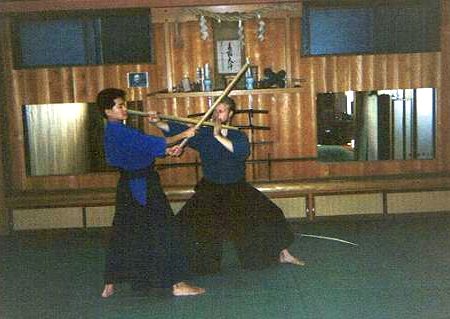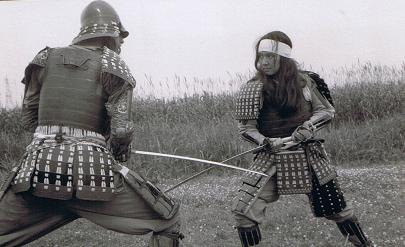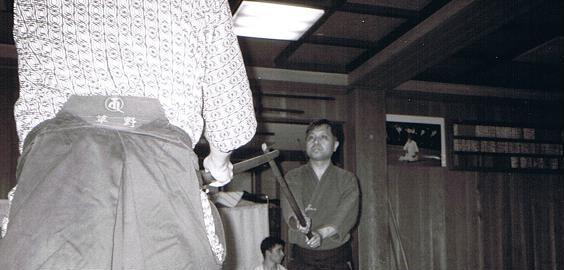copyright
© 2010 Douglas Tong, all rights reserved
The following article is the fourth and final part of an interview conducted on August 7, 2009 in St. Catharines, Ontario, Canada, with Såzen Larsen Kusano Sensei of the Sugino branch of Katori Shinto Ryu. In this article, Såzen Sensei shares with our readers his conceptualization of some of the fundamental ideas in the Sugino-style of Katori Shinto Ryu swordsmanship.
Author’s note: My sincere thanks to Såzen Sensei for his time and generosity in allowing me to interview him at length about his art and his thoughts.
Question: In the first of your seminars, you had mentioned the concept of “meat and bones”. What is this all about?
Sensei: In all kata practice, you’ll find sequences of techniques. To me, all these techniques represent what I call the “bones”. So, for example, one form or kata would be like the bones of the arm, say. And in the arm, you cannot alter the order of the bones. They are pre-set. The finger bones are where they are supposed to be, etc… Each of these bones, each of these techniques, needs to be studied, understood, perfected.
About the order*, forget the order.
(* i.e., the order of the techniques in a kata)
The order does not always make sense. It’s like spelling out the alphabet from A – Z. The letters by themselves don’t make any sense. But they’re all needed in learning how to read and write. Just like understanding all the various techniques. They make up the “fabric” of the school. It’s just a way of practice.* Follow the bones.
(* i.e., kata is just a method to “frame” the practicing of techniques.)
Question: And the meat?
Sensei: The “meat” is when to do what and how. But the combination, they inter-depend, just like in the arm example I gave before.
Without the bones, there is no arm.
Without the meat, there is no arm.
An arm is defined by its function. It moves this way, that way, up, and down. We move the arm freely because we have meat and bones. Remove one or the other and by definition, it’s not an arm anymore.
Question: You have mentioned previously about swordsmanship as a form of “communication”. Can you elaborate on this?
Sensei: In order to fight someone, to practice fighting with someone, you need to communicate. You look at a person, look at what he’s doing or what he’s trying to do. What is he communicating to you? Does he communicate fear? Does he communicate power? Does he communicate contempt? Does he communicate anger?
All this, you’re often able to “notice” by looking. Then, sword meeting sword, what you can’t see, you can feel.

“communication” (Såzen Sensei “communicating” to Mr. Tong)
His skill or lack of skill. He is communicating this quite clearly. His intention. Does he want to hurt you? Is he scared of you? You can understand this by being able to feel his sword, blade on blade.

“feeling the sword”
Question: In your second seminar, you talked about “L-M-R”. Can you explain for sword practitioners what this acronym means?
Sensei: L stands for “look”. M stands for “move”. R stands for “respond”.
Question: How does the concept of “L-M-R” apply to swordsmanship?
Sensei: “Looking” is essential. But it’s very difficult to fight with swords if you can’t “see”. So you need to develop “eyes”, meaning “right observation”.
What do I look for?
Where do I look at?
What do I look at?
Observing, looking, when someone is attacking outside the bones, freely, not in an order, meaning you don’t know where the attack is coming. The most important tool you have is your eyes. By being patient, you look.

“Look”
(Sugino Yukihiro Sensei)
You “look” when the attack is on its way. Only when you have an image on when the attack is coming, and where the opponent is attacking you, then you can “move” out of the way. If you don’t know where the blow is coming, how can you possibly move?
So correct observation means looking. Look at the opponent. Then based on that observation, you move out of the way. Once you’re out of the way, you “respond” with a block or a counter-attack.

“Respond” (Kusano Eri Sensei)
So that’s why every time the opponent is moving in, L-M-R is essential.
Question: Are there any final words you would like to share with our readers?
Sensei: Yes. In the old school of kendo that I represent, the main objective is not to hit (i.e., cut, stab, or hurt) your opponent, but to develop the necessary skills.
Finally, I would like to share a Japanese expression with you. It is “shō jin”. In Japanese, it means “work hard and improve”.

“shō jin” (calligraphy written by Såzen Sensei)
So please everyone work hard, have fun, be safe, and enjoy.
Question: Thank you once again, Sensei, for your time and patience with this lengthy interview. It was a great opportunity to discuss Shinto Ryu and the many interesting things about it.
Sensei: Not at all. You are very welcome!
For more information about Sugino-style Katori Shinto Ryu in Canada, visit: www.tokumeikan.com or http://www.tokumeikan-toronto.blogspot.com/
The following article is the fourth and final part of an interview conducted on August 7, 2009 in St. Catharines, Ontario, Canada, with Såzen Larsen Kusano Sensei of the Sugino branch of Katori Shinto Ryu. In this article, Såzen Sensei shares with our readers his conceptualization of some of the fundamental ideas in the Sugino-style of Katori Shinto Ryu swordsmanship.
Author’s note: My sincere thanks to Såzen Sensei for his time and generosity in allowing me to interview him at length about his art and his thoughts.
Question: In the first of your seminars, you had mentioned the concept of “meat and bones”. What is this all about?
Sensei: In all kata practice, you’ll find sequences of techniques. To me, all these techniques represent what I call the “bones”. So, for example, one form or kata would be like the bones of the arm, say. And in the arm, you cannot alter the order of the bones. They are pre-set. The finger bones are where they are supposed to be, etc… Each of these bones, each of these techniques, needs to be studied, understood, perfected.
About the order*, forget the order.
(* i.e., the order of the techniques in a kata)
The order does not always make sense. It’s like spelling out the alphabet from A – Z. The letters by themselves don’t make any sense. But they’re all needed in learning how to read and write. Just like understanding all the various techniques. They make up the “fabric” of the school. It’s just a way of practice.* Follow the bones.
(* i.e., kata is just a method to “frame” the practicing of techniques.)
Question: And the meat?
Sensei: The “meat” is when to do what and how. But the combination, they inter-depend, just like in the arm example I gave before.
Without the bones, there is no arm.
Without the meat, there is no arm.
An arm is defined by its function. It moves this way, that way, up, and down. We move the arm freely because we have meat and bones. Remove one or the other and by definition, it’s not an arm anymore.
Question: You have mentioned previously about swordsmanship as a form of “communication”. Can you elaborate on this?
Sensei: In order to fight someone, to practice fighting with someone, you need to communicate. You look at a person, look at what he’s doing or what he’s trying to do. What is he communicating to you? Does he communicate fear? Does he communicate power? Does he communicate contempt? Does he communicate anger?
All this, you’re often able to “notice” by looking. Then, sword meeting sword, what you can’t see, you can feel.
“communication” (Såzen Sensei “communicating” to Mr. Tong)
His skill or lack of skill. He is communicating this quite clearly. His intention. Does he want to hurt you? Is he scared of you? You can understand this by being able to feel his sword, blade on blade.
“feeling the sword”
Question: In your second seminar, you talked about “L-M-R”. Can you explain for sword practitioners what this acronym means?
Sensei: L stands for “look”. M stands for “move”. R stands for “respond”.
Question: How does the concept of “L-M-R” apply to swordsmanship?
Sensei: “Looking” is essential. But it’s very difficult to fight with swords if you can’t “see”. So you need to develop “eyes”, meaning “right observation”.
What do I look for?
Where do I look at?
What do I look at?
Observing, looking, when someone is attacking outside the bones, freely, not in an order, meaning you don’t know where the attack is coming. The most important tool you have is your eyes. By being patient, you look.
“Look”
(Sugino Yukihiro Sensei)
You “look” when the attack is on its way. Only when you have an image on when the attack is coming, and where the opponent is attacking you, then you can “move” out of the way. If you don’t know where the blow is coming, how can you possibly move?
So correct observation means looking. Look at the opponent. Then based on that observation, you move out of the way. Once you’re out of the way, you “respond” with a block or a counter-attack.
“Respond” (Kusano Eri Sensei)
So that’s why every time the opponent is moving in, L-M-R is essential.
Question: Are there any final words you would like to share with our readers?
Sensei: Yes. In the old school of kendo that I represent, the main objective is not to hit (i.e., cut, stab, or hurt) your opponent, but to develop the necessary skills.
Finally, I would like to share a Japanese expression with you. It is “shō jin”. In Japanese, it means “work hard and improve”.
“shō jin” (calligraphy written by Såzen Sensei)
So please everyone work hard, have fun, be safe, and enjoy.
Question: Thank you once again, Sensei, for your time and patience with this lengthy interview. It was a great opportunity to discuss Shinto Ryu and the many interesting things about it.
Sensei: Not at all. You are very welcome!
For more information about Sugino-style Katori Shinto Ryu in Canada, visit: www.tokumeikan.com or http://www.tokumeikan-toronto.blogspot.com/